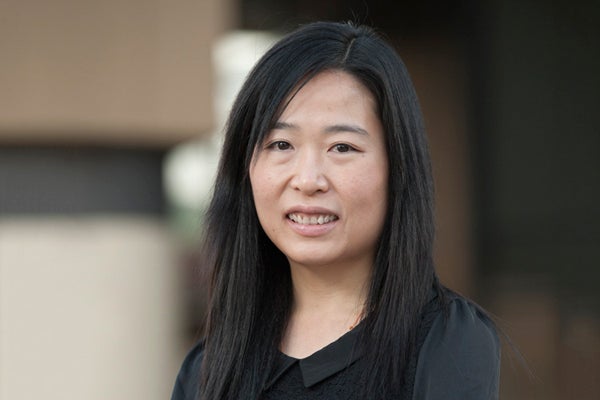|
October 7, 2014
Miniature wireless device being developed by Stanford Bio-X team creates better way of studying chronic pain
A team of Stanford Bio-X scientists and engineers is creating a small wireless device that will improve studies of chronic pain. The scientists hope to use what they learn to develop better therapies for the condition, which costs the economy $600 billion a year. By Amy Adams

Ada Poon, assistant professor of electrical engineering at Stanford, is working with a team of scientists to find better ways to treat chronic pain. (Linda Cicero / Stanford News Service)
Ada Poon, a Stanford assistant professor of electrical engineering, is a master at building miniscule wireless devices that function in the body and can be powered remotely. Now, she and collaborators in bioengineering and anesthesia want to leverage this technology to develop a way of studying – and eventually developing treatments for – pain.
Chronic pain costs the economy $600 billion a year and the two most common treatments have significant drawbacks: narcotics are addictive and surgery is costly and carries considerable risks.
"Many people simply can't find a medication or technique to control their pain, despite all the approaches available," said David Clark, a professor of anesthesiology and pain management who treats patients with chronic pain in his medical practice. "Most people don't even achieve 50 percent pain control."
The collaboration builds on work by Scott Delp, professor of bioengineering and mechanical engineering, and his students Kate Montgomery, who is a Bio-X fellow, and Shrivats Iyer. They developed a way of using light to control the activity of neurons that transmit pain, taking advantage of a technique called optogenetics. One color of light stopped the nerve from firing and prevented pain. Another color caused the nerve to fire.
To be clear, the work involved genetically engineering nerves in mice to be responsive to light, and is therefore not something that can currently be done in humans. But the work did point to a new way of studying how the sensation of pain is transmitted to and from the brain and, potentially, developing or testing better therapies.
Despite promise as a new model for studying pain, the initial approach had limitations. Since the light came through a cumbersome fiber optic cable, the mice couldn't move freely or use exercise wheels. It wasn't a natural environment and so any insights might not be relevant to humans.
"Right now, the only way to study pain is an indirect method," Poon said. And that indirect method has so for not been successful in generating new therapies.
"We've had failure after failure to translate drugs that were successful in animals to humans," Clark said. "This puts a premium on understanding how we should be studying pain."
Coupling a wireless technology to optogenetics eliminates the wire and allows a mouse to move freely, use an exercise wheel and socialize. Clark said this combination will allow researchers to design experiments that more closely mirror a patient's experience.
For example, Clark said that when he sees patients they don't necessarily complain only about the pain. They complain about not wanting to see friends, not being able to go to work, or not being able to do activities they enjoy.
"What we will be able to look at is a more natural measure of pain relief," Poon said. They could assess whether a treatment allows mice to return to normal activities by tallying time spent on an exercise wheel or socializing.
This collaboration is one of 22 projects recently funded by the Stanford Bio-X Seed grants, which Carla Shatz, the director of Bio-X, calls the "glue" that brings interdisciplinary teams together. This project is typical, with an electrical engineer, a bioengineer and an anesthesiologist, all of whom are Bio-X affiliates, working together to solve a biomedical problem. Bio-X has so far brought together more than 600 interconnected faculty members from across campus.
"When you combine people with different skills you will come up with something with truly high impact," Clark said.
For more Stanford experts on biosciences and other topics, visit Stanford Experts.
-30-
|